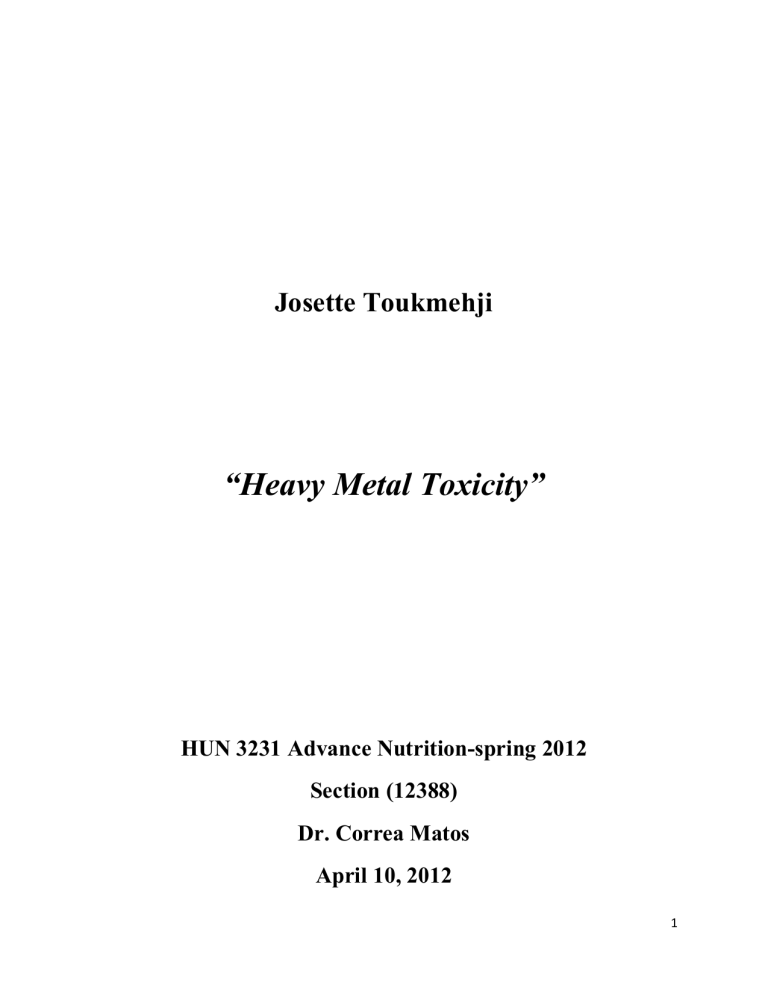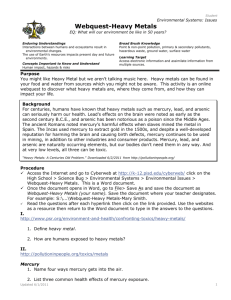File
advertisement

Josette Toukmehji “Heavy Metal Toxicity” HUN 3231 Advance Nutrition-spring 2012 Section (12388) Dr. Correa Matos April 10, 2012 1 Table of Contents: Introduction…………………………………………………………..…3 Heavy Metal Toxins…………………………………………………....3-4 Arsenic……………………………………………………………....….4-6 o Sources of Arsenic Contamination….………….………..4 o Symptoms of Arsenic Poisoning………………….……..4-5 o Arsenic Mechanism of Toxicity…………………………5-6 Lead………………………………………………………………….....6-8 o Sources of Lead Contamination…………………..……..6 o Symptoms of Lead Poisoning……………………….……7 o Lead Mechanism of Toxicity……………………………7-8 Mercury………………………………………………………………..8-10 o Sources of Mercury Contamination………………..…..8-9 o Symptoms of Mercury Poisoning………………………..9 o Mercury Mechanism of Toxicity……………………..…10 Conclusion………………………………………………………..…….10 Appendix……………………………………………………………...11-12 References………………………………………………………………13 2 Introduction: During the past few decades human exposure to heavy metal toxins has increased dramatically. This can be attributed to the urban, industrial and agricultural activities of the human population which causes soil and water contamination by toxic metals and leads into many environmental problems. Such detrimental practices include air pollution as a result of car emissions; long periods of using pesticides containing copper and the application of domestic waste and sewage as fertilizers. Naturally our diet contains small amounts of metal elements which are necessary for a healthy body. However, when those elements are present in increased amounts they can cause acute or chronic toxicity. For most heavy metals, toxic levels can be just above the concentration that is naturally found in nature. Although most people have the capability to get rid of those toxins from their bodies, others can develop a build up of those heavy metals. The accumulation of those metals in the body over time can lead to sever adverse effects that mimic the symptoms of certain diseases such as autism, depression, Parkinson chronic fatigue symptoms and multiple sclerosis. As a result, it is considered essential for us to educate ourselves about those adverse affects and how to prevent increased exposure to those metal elements. [1, 2, 3] Heavy Metal Toxins: Some heavy metals are toxic to human beings and some have an important function in our bodies. All living beings require different amounts of certain metals, such as iron, cobalt, copper, manganese, and zinc. Although these metals are needed, excess of them can be harmful. On the other hand, there are other metals that have no beneficial effects which include mercury, cadmium, arsenic and lead. The body cannot use any of those metals in its bioprocesses and 3 therefore any small increase in their concentrations will cause them to interfere in the normal biological processes leading to acute or chronic toxicity. [4] Arsenic: Sources of Arsenic Contamination: Arsenic is the most common cause for heavy metal toxicity. An interesting fact about arsenic is that it was recorded in history that it was for suicidal and homicidal uses. Arsenic is produced as a byproduct of the smelting process of copper, zinc and lead [7]. Arsenic is also used as a pesticide and a wood preservative due to its ability to kill insects, fungi and bacteria. The metal has been extensively used for this propose until 2004 when toxicity issues started to surface and led to its ban. As a result, much fertile soil is considered today contaminated with arsenic due to the many years of its use as a pesticide. In addition to that, an arsenic additive called roxarsone is still widely used in poultry production in order to promote growth, enhance meat texture and kill parasites [5]. Other sources of arsenic toxicity include rat poisons, foods that are collected from aquatic environments where fish is found to be contaminated [7]. Symptoms of Arsenic Poisoning: Symptoms of acute arsenic poisoning vary based on the contact form with the harmful metal. For example if inhaled, arsenic causes sore throat, mucosal irritation and difficulty in breathing. If the metal gets into contact with the skin, it causes redness and swallowing. Ingestion leads into more serious side effects usually within one hour and they include vomiting, abdominal pain and diarrhea. Those side effects can be accompanied by fever and arrhythmia. Chronic side effects which occur as a result of prolonged contact with lower levels of arsenic 4 include damage to the peripheral and central nervous system, muscle tingling and numbness and a tingling feeling in the hands and feet. Over several years neuropathy occurs which might associated with darkening of certain area of the skin. Another serious side effect of arsenic is that fact that it is carcinogenic and might lead to different forms of cancer and malignancies. Liver damage also is considered inevitable with arsenic toxicity [5, 8,10]. Arsenic Mechanism of Toxicity: Although the mechanism of arsenic toxicity is not fully understood, it is believed that arsenic’s inhibition of DNA enzymes that are responsible for replication and repair in addition to arsenate’s ability to act as a phosphate analog play a major role in the process. Arsenic causes cellular toxicity by attacking mitochondrial enzymes and resulting in failed tissue respiration. Another mechanism of arsenic toxicity is its affinity for thiol groups such as dihydrolipoic acid which results in changing those enzymes that are required for cellular respiration. As figure 1 in the Appendix shows, arsenic attack on thiol groups alters two enzymes which are dihydrolipoyl dehydrogenase and dihydrolipoyl transacetylase. Those two enzymes are considered essential in the conversion cycle of pyruvate to acetyl CoA during tissue respiration. Therefore when those enzymes are altered, the conversion of lipoic acid to acetyl lipoic acid and in turn to acetyl CoA is disrupted [10]. Arsenic was also found to inhibit dehydrogenase and stimulate mitochondrial adenosine triphosphatase activity by the uncoupling of oxidative phosphorylation. Recent studies have shown that arsenic have the ability to replace phosphorous in many biochemical reactions. As shown in figure 2 in the appendix, when arsenic is absent, ADP phosphorylates into ATP. However, when arsenic is present, it inhibits the formation of ATP during glycolysis by substituting phenylarsonic acid (which is less stable) for phosphorous. This results in the formation of ADP-arsenate which undergoes spontaneous and irreversible decomposition 5 causing the metabolizing cell to lose energy in the process. In addition to that, it increases the production of free radicals leading to porphyrinuria and hepatotoxicity which are commonly associated with acute exposure to arsenic as shown in figure 3 in the Appendix [8, 10]. Lead: Sources of Lead Contamination: Lead is the second most toxicity-causing metal due to the fact that it is present in food and water supplies that are contaminated. Drinking water collected from geological strata can contain significant amounts of lead. In areas where gold zinc and other economically beneficial metals are extracted, led is also present as an ore contaminant because it’s involved in mining byproducts. According to estimates made by the National Institute of Occupational Safety and Health (NIOSH), more than 3 million workers in the United States are potentially exposed to lead in the workplace [11]. Under normal circumstances, there is a balance of lead in the body, which means that the individual can expel as much as he can consume as long as the tissue levels are under the concentrations which lead to pathological changes. An increase of the intake of lead can lead to positive lead balance. Lead is transported to the plasma and membrane sites in soft tissues especially the bones and teeth due chemical structure similarities of both lead and calcium chemical structures. This similarity causes the body to treat lead as if it were calcium. In the next section there will be further discussion about the side effects and symptoms of lead toxicity [11, 4]. 6 Symptoms of Lead Poisoning: As we ingest more lead the worst the toxicity can get and lead to heightened toxicities in which can cause a mucosal tissue damage in the GI tract, and convulsions leading to death. Furthermore, chronic lead intoxication happens as a result of a buildup of positive lead balance and some symptoms may occur such as clumsiness, ataxia, vertigo, irritability, and insomnia. In addition to all these symptoms, one of the most noticeable symptoms is the lead lines at the gingival border in the mouth because it is secreted in the saliva following the same pathway as the calcium [4]. Lead Mechanism of Toxicity: Although the mechanism to lead-induced toxicity is not fully understood, its affinity to sulfhydryl groups found on many enzymes and the ability of this metal to mimic calcium ions are considered to be the main factors behind lead’s toxic effects. Lead binds to the sulfhydryl groups that are part of the structure of many enzymes therefore disrupting the functions of the enzymes themselves. In addition to that, lead’s affinity for calcium-activated proteins is much higher than that of calcium itself; therefore causing the disruption of biological reactions that rely on calcium as a cofactor for activation. Studies have shown that Pb2+ enters the cell by the same channel transporters that are responsible for Ca2+ transportation therefore disrupting the equilibrium of cellular calcium concentration and causing lead buildup. As we have described in the previous section, lead toxicity is known to cause anemia because lead disrupts the activity of deltaaminolevulinic acid dehydratase also known as ALAD and another enzyme called ferrochelatase as shown in “Figure 4” in the appendix. Both of those enzymes are responsible for the production of heme which is a component of hemoglobin. Disruption of heme production in red 7 blood cells leads into anemia and the buildup specific neuron-damaging substances such as aminolevulinic acid. Another pathway by which lead causes toxicity to the neurons is by blocking the release of a neurotransmitter called glutamate. This is achieved by targeting and blocking NMDA receptors causing neuron cell death [14]. Mercury: Sources of Mercury Contamination: Mercury is considered to be the third most toxicity-causing heavy metal. It is naturally found in the environment as a result of the volcanic emissions that are released from earth’s crust. Mercury is present in nature in its three forms which are elemental mercury, organic and inorganic mercury [5]. Inorganic mercury includes metallic mercury and mercury vapor (Hg0) and mercurous (Hg2++) or mercuric (Hg++) salts. Moreover, organic mercury includes compounds that have mercury atoms attached to carbon based structures such as methyl, ethyl, phenyl and other groups [6]. There are many sources by which humans are exposed to this metal. For example mining operations, chloralkali plants, and paper industries are significant causes of mercury contamination. Mercury in its atmospheric form is spread by wind and it returns to earth through rainfall where it is then spread to aquatic food chains. Contaminated fish that contains mercury is considered to be one of the important factors that lead to human poisoning from this metal. Mercury was also used as a fungicide until the early nineteen nineties and it was added to paints as such, therefore those sources are still considered as potential contaminants due to the existence of old paints years after it was banned. Other sources of human exposure to mercury are dental amalgam, broken thermostats and thermometers, certain medicines such as Mercurochrome and Merthiolate and some children vaccines. Inhalation is the main route by 8 which elemental mercury vapor is absorbed into the body, where it enters through mucus membranes and the lungs and rapidly oxidizes to other forms. Organic mercury is easily absorbed through the gastrointestinal tract and then becomes deposited in the tissue. Although it is not as efficient as elemental mercury in crossing the blood-brain barrier, however once it does, organic mercury gets transformed into the elemental form [5, 6]. Symptoms of Mercury Poisoning: An organ targeted in mercury toxicity depends on the type of exposure towards the metal forms. Inhaled mercury vapor is what mainly affects the brain. As for Mercurous and mercuric salts, they target the kidneys and damage the gastrointestinal lining. In addition, methyl mercury can spread all over the body. As mentioned in previous sections of this paper, there are three types of mercury toxicities and each has different associated symptoms. Inorganic mercury can impair the function of any organ or subcellular structure. Furthermore, it can target the peripheral nerve, renal function, immune, endocrine, and muscle functions, and many types of dermatitis, especially if the level of exposure is very high. Moreover, the affected individual may show signs of severe behavior and personality changes, loss of memory, insomnia, depression, fatigue, and hallucinations. As for low level of exposures, symptoms like weakness, fatigue, anorexia, weight loss, gastrointestinal disturbance may occur. Mercuric mercury symptoms of toxicity include precipitation of entrocyte proteins, abdominal pain, vomiting, and bloody diarrhea with necrosis of the gut mucosa may occur. Organic mercury is another form that causes toxicity by getting in the way of DNA transcription and protein synthesis. Not only that, but there have been some data showing the effect of organic mercury toxicity on organs by impairing the function of mitochondria, inducing free radical formation, and disrupting neurotransmitters [5, 6]. 9 Mercury Mechanism of Toxicity: Mercury is a very poisonous element and its toxicity mechanism varies based on whether the exposure was to elemental, organic or inorganic form of the metal. All forms of mercury are known to cause toxicity by disrupting the tertiary and quaternary structures of proteins; in addition to that, they bind with sulfhydryl and selenohydryl groups. This gives mercury the ability to disrupt the function of any organ in the body [6]. The metal was also found to have immunotoxic effects by first inducing the immune to system to produce antibodies to its own proteins in process called autoimmunity. Autoimmunity causes the destruction renal basement membrane proteins and eventually kidney failure. A second and more direct mechanism by which mercury impairs immunity is through the disruption of Th1 and Th2 responses therefore affecting the response towards antigens. Studies in animals have shown that both organic and inorganic mercury reduces immunity resistance towards a range of infectious diseases, including Coxsackie virus, influenza, salmonella, and malaria [11-13]. Conclusion: 10 Appendix: Graph 1: Arsenic Mechanism of Disrupting Cellular Respiration [10]. The arsenic attack on thiol groups alters dihydrolipoyl dehydrogenase and dihydrolipoyl transacetylase. Those two enzymes are considered essential in the conversion cycle of pyruvate to acetyl CoA during tissue respiration. Therefore when those enzymes are altered, the conversion of lipoic acid to acetyl lipoic acid and in turn to acetyl CoA is disrupted. Graph 2: Arsenic Substitution for Phosphorous during ATP Production [10]. When arsenic is absent, ADP phosphorylates into ATP. However, when arsenic is present, it inhibits the formation of ATP during glycolysis by substituting phenylarsonic for phosphorous. This results in the formation of ADParsenate which undergoes spontaneous and irreversible decomposition causing the metabolizing cell to lose energy in the process. 11 Graph 3: Effects of Arsenic Poisoning in the Tissue [10]. Arsenic increases the production of free radicals leading to porphyrinuria and hepatotoxicity which are commonly associated with acute exposure to arsenic as shown in figure 3 in the Appendix. Graph 4: Lead Toxic Effects [14]. Disruption of the activity of delta-aminolevulinic acid dehydratase also known as ALAD. 12 References: 1. SixWise. Heavy Metal Toxicity: Signs and Symptoms That you May be Toxic 2009. http://www.sixwise.com/Newsletters/2009/November/13/Heavy-Metal-Toxicity-Signsand-Symptoms.htm. Accessed April 1, 2012. 2. Francois Briat, Michel Lebrun. Plant responses to Metal Toxicity.2009;43-54. 3. Francois Briat, Michel Lebrun. Plant responses to Metal Toxicity.2009;43-54. 4. Dr. Theodore B. Hoekman. Heavy Metal Toxicology. http://customers.hbci.com/~wenonah/hydro/heavmet.htm. Accessed April 1, 2012. 5. Life Extension. Health Concerns; Heavy Metal Toxicity. http://www.lef.org/protocols/prtcl-156.shtml#merc. Accessed April 1, 2012. 6. Robin A. Bernhoft. Mercury Toxicity and Treatment; A review of the Literature. PubMed. 2011. 7. Infinite Health. Heavy Metals in Your Body 2007. http://www.infinitehealthresources.com/Store/Resource/Article/1-4/2/1156.html. Accessed April 1, 2012. 8. Kiberlie A Graeme MD, Charles V Pollack Jr. Heavy Metal Toxicity, Part I; Arsenic and Mercury. 1988; 45-56. 9. Thomas W. Clarkson, Lasxlo Magos. Informa Health Care. The Toxicology of Mercury and its Chemical Comounds. 2009;36;609-662. 10. Obinaju, Blessig Ebele. Mechanisms of Arsenic Toxicity and Carcinogenesis 2009;232237. 11. D.A. Lawrence, M.J. McCabe, Immune Modulation by Toxic Metals, in: R.A. Goyer, C.D. Klaassen, M.P. Waalkes (Eds.), Metal Toxicology, Academic Press, 1995, pp. 305– 337. 12. E.K. Silbergeld, J.B. Sacci, A. Azad, Mercury and malaria: interactions between metal exposure and host resistance 13. Ellen K Silbergeld, Patrick J Devine. Mercury--- Are We Studying the Right Endpoints and Mechanisms. 2000;35-42. 14. Altern Med. Lead Toxicity Part II; The Role of Free Radical Damage and the Use of Antioxidants in the Pathology and Treatment of Lead Toxicity. 2009;11(2):1114-127. 13








